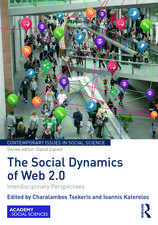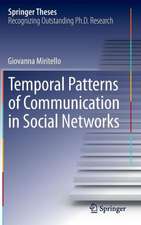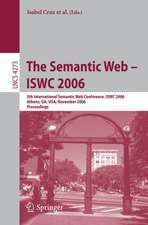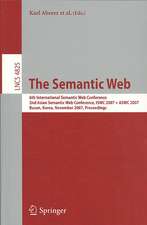Social Networks and the Semantic Web: Semantic Web and Beyond, cartea 5
Autor Peter Mikaen Limba Engleză Hardback – 18 sep 2007
| Toate formatele și edițiile | Preț | Express |
|---|---|---|
| Paperback (1) | 757.01 lei 6-8 săpt. | |
| Springer Us – 29 noi 2010 | 757.01 lei 6-8 săpt. | |
| Hardback (1) | 648.59 lei 6-8 săpt. | |
| Springer Us – 18 sep 2007 | 648.59 lei 6-8 săpt. |
Preț: 648.59 lei
Preț vechi: 810.74 lei
-20% Nou
Puncte Express: 973
Preț estimativ în valută:
124.10€ • 129.58$ • 102.71£
124.10€ • 129.58$ • 102.71£
Carte tipărită la comandă
Livrare economică 05-19 aprilie
Preluare comenzi: 021 569.72.76
Specificații
ISBN-13: 9780387710006
ISBN-10: 0387710000
Pagini: 234
Ilustrații: XIV, 234 p.
Dimensiuni: 156 x 235 x 20 mm
Greutate: 0.5 kg
Ediția:2007
Editura: Springer Us
Colecția Springer
Seria Semantic Web and Beyond
Locul publicării:New York, NY, United States
ISBN-10: 0387710000
Pagini: 234
Ilustrații: XIV, 234 p.
Dimensiuni: 156 x 235 x 20 mm
Greutate: 0.5 kg
Ediția:2007
Editura: Springer Us
Colecția Springer
Seria Semantic Web and Beyond
Locul publicării:New York, NY, United States
Public țintă
ResearchCuprins
to the Semantic Web and Social Networks.- The Semantic Web.- Social Network Analysis.- Web data and semantics in social network applications.- Electronic sources for network analysis.- Knowledge Representation on the Semantic Web.- Modelling and aggregating social network data.- Developing social-semantic applications.- Case studies.- Evaluation of web-based social network extraction.- Semantic-based Social Network Analysis in the sciences.- Ontologies are us: emergent semantics in folksonomy systems.- Conclusions.- The perfect storm.
Notă biografică
Textul de pe ultima copertă
We are not just building the Web any more: we are on it. The latest set of applications have transformed the Web from a mere document collection into a social space: the new services developed under the banner of Web 2.0 cater to our needs of connecting through the medium and allow us to explicitly describe, maintain and develop our online self. At the same time, documents and other forms of content are not only up- and downloaded any more, but actively exchanged, filtered, organized and discussed in groups of all sizes. While the pace of change is dizzying, investigating this complex social-technological system is paramount to our ability of designing intelligent information systems that can guide us through the new online universe.
Social Networks and the Semantic Web combines the concepts and the methods of two fields of investigation, which together have the power to aid in the analysis of the social Web and the design of a new class of applications that combine human intelligence with machine processing. Social Network Analysis and the emerging Semantic Web are also the fields that stand to gain most from the new Web in achieving their full potential. On the one hand, the social Web delivers social network data at an extraordinary scale, with a dynamics and precision that has been outside of reach for more traditional methods of observing social structure and behavior. In realizing this potential, the technology of the Semantic Web provides the key in aggregating information across heterogeneous sources. The Semantic Web itself benefits by incorporating user-generated metadata and other clues left behind by users.
Social Networks and the Semantic Web is designed for practitioners and researchers in industry, as well as graduate-level students in Computer Science within the Semantic Web field, and Social Science with an interest in working with electronic data and observing online social networks. This book also supplies developers of social-semantic applications with an understanding of the key concepts and methods of both fields and describes real-world applications incorporating social and semantic metadata.
Foreword by Frank van Harmelen, author of the Semantic Web Primer
Social Networks and the Semantic Web combines the concepts and the methods of two fields of investigation, which together have the power to aid in the analysis of the social Web and the design of a new class of applications that combine human intelligence with machine processing. Social Network Analysis and the emerging Semantic Web are also the fields that stand to gain most from the new Web in achieving their full potential. On the one hand, the social Web delivers social network data at an extraordinary scale, with a dynamics and precision that has been outside of reach for more traditional methods of observing social structure and behavior. In realizing this potential, the technology of the Semantic Web provides the key in aggregating information across heterogeneous sources. The Semantic Web itself benefits by incorporating user-generated metadata and other clues left behind by users.
Social Networks and the Semantic Web is designed for practitioners and researchers in industry, as well as graduate-level students in Computer Science within the Semantic Web field, and Social Science with an interest in working with electronic data and observing online social networks. This book also supplies developers of social-semantic applications with an understanding of the key concepts and methods of both fields and describes real-world applications incorporating social and semantic metadata.
Foreword by Frank van Harmelen, author of the Semantic Web Primer
Caracteristici
Valuable for practitioners developing social-semantic software for the Web Author provides descriptions that allow the reader to not only reproduce his work but also to apply his methods in a wide range of settings Accessible to social scientists with an interest in electronic data, and to information scientists with an interest in social-semantic applications
































